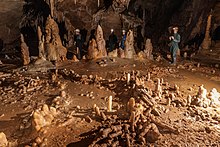Stone circles in the Bruniquel cave

The stone circles in the Bruniquel cave , east of Montauban in the Tarn-et-Garonne department in Occitania in south-west France are designs made of broken stalactites , or more precisely stalagmites , 350 m inside the cave.
The cave was naturally closed during the Pleistocene and no one entered it until the then 18-year-old student Bruno Kowalczewski rediscovered it on February 24, 1990 after three years of sole excavation. A map of all fragments was drawn up in 1992, the 35 by 25 meter hall was measured in 1993, and a burned bone was dated to more than 47,600 years using C14 dating. Research stopped in 1999 with the death of excavation director François Rouzaud and it remained unclear whether the structures could be ascribed to the Neanderthals .
In 2013, Jacques Jaubert and his colleagues examined and dated the structures and published the results of their research in the journal Nature in 2016 . The investigation of the uranium isotopes in the broken lime cones by the Chinese dating specialist Hai Cheng revealed an age of 176,500 years (± 2100 years) in 2014, so that the structures can be assigned to the Neanderthal.
The stone structures were found when the cave was discovered in 1990, but were not initially explored. They are located 336 meters from the cave entrance. Two oval structures are striking: one about 6.7 by 4.5 meters and one 2.2 by 2.1 meters. They are made up of four stacked rows of roughly equal sized stalactite pieces. The stones used are stalagmites , i.e. those that grow up from the ground. In the middle of the rows, the researchers found smaller pieces that strengthen the structure. For the same reason, some stalactites are leaned against the rows from the outside. There are also four stalagmite piles with diameters between 0.55 and 2.6 meters, two of which are inside and two outside of the large ring. About 400 pieces of stalagmite (called “speleofacts” by the researchers) with a total length of 112.4 meters and a weight of about 2.2 tons were built.
Only a few stalagmites are intact, half of them in the middle, without a base or point. The stalagmite pieces are well calibrated, with average lengths of 34.4 cm for the large and 29.5 cm for the small ring, which, in Jaubert's view, indicates a deliberate construction. All structures show signs of fire, with 57 reddened and 66 blackened pieces in 18 locations. Burned organic material was found, including the 6.7 cm long bone of a bear or similarly large herbivore. The discovery suggests that the extinct relatives of modern humans possessed more complex social structures than previously thought. Modern humans in Aurignacia did not build cave structures (over 100,000 years later). No other evidence of human activity or painting was found. However, the impression of a finger was discovered.
Karst caves are hostile environments. Prior to the discovery of Bruniquel, constructions in caves that required artificial light were unknown. Even in the caves sporadically visited by modern humans during the Younger Paleolithic , there are no comparable constructions. According to the findings, it can hardly be denied that the Neanderthals had cognitive, social and verbal abilities. In addition, there is the control of the fire, among other things in the function as an indispensable means of orientation in the darkness of the grotto. The fat from the bones served as fuel, which burned like an oil lamp and provided around two hours of light, as was shown by experiments in experimental archeology in 2017. In addition, the bones generate significantly less smoke than wood. This lighting was also mobile, so that it could be used like a kind of torch.
The Canadian ethno-archaeologist Bryan Hayden ruled out residential use, but suspects a connection to today's hunting ideas.
literature
- Jacques Jaubert , Sophie Verheyden, Dominique Genty, Michel Soulier, Hai Cheng, Dominique Blamart, Christian Burlet, Hubert Camus, Serge Delaby, Damien Deldicque, R. Lawrence Edwards , Catherine Ferrier , François Lacrampe-Cuyaubère, François Lévêque, Frédéric Maksud, Pascal Mora, Xavier Muth, Édouard Régnier, Jean-Noël Rouzaud, Frédéric Santos: Early Neanderthal constructions deep in Bruniquel Cave in southwestern France. Nature 534.7605 (2016): 111. doi : 10.1038 / nature18291
Web links
- Luc-Henri Fage: In the footsteps of the Neanderthals - The riddle of the Bruniquel cave , Arte, 2019 (53:26 min)
- Video
- Video
- Cave Structures Shed New Light on Neanderthals
Coordinates: 44 ° 3 ′ 43 " N , 1 ° 40 ′ 34" E